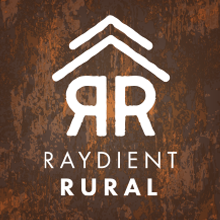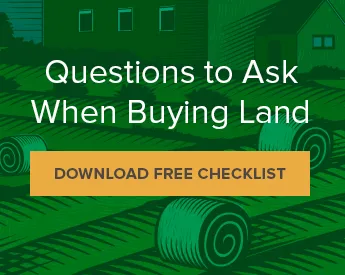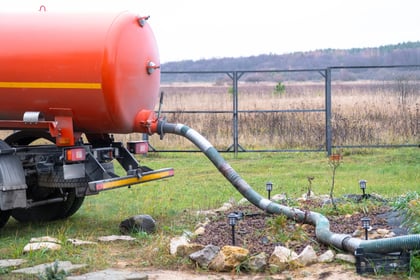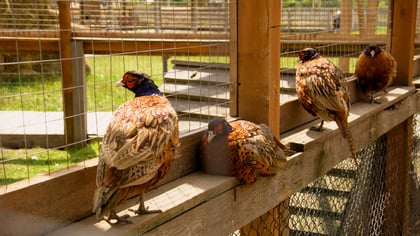7 Ways Landowners Can Protect Nature & Preserve Biodiversity

We're celebrating Earth Day by sharing 7 ways landowners can use their property (large or small) to protect nature, preserve biodiversity, and help make the world a better place.
Living close to nature is one of the greatest pleasures and benefits of country living.
Daily connection with the natural world reduces stress and feeds our souls. It provides ample wholesome activities for growing children and is incredible for our physical, mental and emotional health.
Owning acreage, whether it’s several hundred acres or a small hobby farm, offers us a unique opportunity to give back by using our land to protect nature while conserving its valuable resources.
In celebration of Earth Day, we share seven ways you can use your land to benefit wildlife, eco-diversity, waterways, air quality, and more.
7 Ways to Use Your Land to Protect & Preserve Biodiversity and Ecosystems
You don’t have to be an environmentalist, conservation expert or naturalist to create a property that preserves and promotes biodiversity and healthy ecosystems.
Helping conserve and protect ecosystems benefits everyone, from microscopic soil microbes that create healthier crops and gardens to the game that nourishes hunters and their families and the fish that provide recreation and swim in the waterways we all rely on.
Here are seven ideas anyone can implement on their rural land to promote plant and wildlife diversity, create cleaner air and water, grow healthier forests, avoid natural disasters and improve environmental health.
1. Utilize free local resources to turn your property into a wildlife paradise
So often, we are bombarded with heartbreaking news stories about declining wildlife populations and wish there was something we could do.
Fortunately, if you own land, your state’s fish and wildlife commission may help you use it to benefit wildlife, insects, plant populations and more.
In How Florida’s Fish and Wildlife Conservation Commission Will Help You Turn Your Land into a Wildlife Paradise we talked to representatives from the Florida Wildlife Commission about two state-funded programs designed to help landowners attract, nurture, and protect wildlife.
The first program, “Backyards and Beyond” is designed to help landowners in their backyards.
The second, “Land Owner’s Assistance Program,” provides carious assistance and tools for land owners of larger tracts.

Per Program representative Peter Kleinhenz, : “If you have 1 to 10 acres, all you have to do is think about: What do species need to survive? Which is:
- Food
- Water
- Shelter
- And space to raise young.
“If we’re thinking about those things and applying proper practices, then wildlife will thrive.”
Examples include:
- Planting native plants: Food
- Making a brush pile (instead of throwing branches out on the street): Shelter
- Adding water: Such as bird bath, small fish pond, water garden or lake
For larger land tracts, FWC would send out a representative to make customized recommendations such as prescribed burning, reforesting through cost-share programs, setting up pollinator habitats, installing bird boxes, preserving wetlands, and much more.
And the best part? The LAP is paid for by taxes and hunting and fishing licenses so it’s free to engage a representative for a property assessment.
Yes, there is a cost for the practices you wish to implement, but those may be very low thanks to a variety of cost-sharing programs.
Many states have programs like this available, so check your local fish and wildlife department for more details.
2. Make your property irresistible to pollinators
This is one of the easiest things you can do to promote biodiversity of plants, insects and animal species.
Many types of pollinators, such as honey bees, are now threatened, which is also a threat to human survival because without them, we lose a significant amount of our food.
When you look at it this way, you can see how the decline in pollinators affects us all, not just the insect population.
Fortunately, anyone can take steps to turn any size property into a pollinator paradise.

Some ways to do this include:
- Building bat boxes: Yep, bats are essential pollinators too! Click the link to learn more.
- Planting a pollinator garden: Learn how here.
- Avoiding spraying pesticides and insecticides: These are two of the biggest threats to pollinators.
- Practice integrative pest control: This utilizes natural insecticides and companion planting, which attracts predatory bugs to prey on the pesky bugs without harming beneficial insects, like honeybees and other pollinators.
- Letting parts of your property go wild: Pollinators love feeding on wild flowers and other tall grasses and flowering plants.
- Plant different flowers that will bloom all year: This ensures a steady supply of food for pollinators and a steady stream of beautiful color throughout the long Southern growing season.
- Use lots of color in your gardens and landscaping: This will attract many different types of pollinators.
- Provide some shelter plants like trees and bushes for hummingbirds and other pollinating birds and insects to make their nests.
Get more tips in:
- Companion Planting: Nature’s Free Organic Pest Control
- How to Plant a Pollinator Garden in the South
- The Benefits of a Bat Box
3. Practice regenerative organic gardening and agriculture
Regenerative organic agriculture is creating a buzz for good reason, it’s been shown effective at protecting various ecosystems, capturing and sequestering carbon while benefitting farmers, growers, wildlife and communities.
The term “Regenerative organic” was coined by Robert Rodale, J.I. Rodale’s son (of the Rodale Institute).
It means a farm or garden goes beyond just being sustainable or organic and instead seeks to regenerate soil and ecosystems for the betterment of the farm, the community and the planet.
Some examples of regenerative organic agriculture or gardening practices include:
- Not using synthetic pesticides or herbicides, which pollute the soil, water and air while harming beneficial insects and other wildlife.
- Utilizing compost to feed the soil.
- Using low-till or no-till methods, which protect soil health and help keep carbon in the soil.
- Using cover crops to protect topsoil and nourish the soil ecosystem.
- Utilizing animals to fertilize the soil, and treating those animals humanely.
- Incorporating agroforestry practices, like Silvopasture, to protect wildlife while nourishing the soil and land.
- Avoiding monocropping in favor of plant diversity and crop rotation.
- Utilizing companion planting to attract and nourish beneficial insects.
All these principles can be applied on a farm- or garden-scale to provide immense benefits for soil, wildlife, insects and other ecosystems while also capturing a significant amount of carbon via the plants, cover crops and soil.

In a garden, for example, you could do the following:
- Start a compost pile and use it to amend your soil prior to planting.
- Plant a diverse amount of plants/crops versus just one or two.
- Try pesticide alternatives like companion planting or DIY natural pesticides like soap and cayenne pepper spray.
- After harvest, plant a cover crop like red clover, oats or peas to nourish the soil and protect topsoil from degrading or blowing away in the colder months.
To learn more about regenerative organic farming, check out the Netflix documentary Kiss the Ground, narrated by Woody Harelson.
For more organic gardening tips, see:
4. Take steps to prevent unwanted wildfires on your land
Prescribed burning can be very beneficial for managing healthy forests and pastureland and preventing megafires.
However, uncontrolled and unplanned forest fires can be devastating for wildlife, people, air quality, aquatic systems and the environment.
In Commonsense Tips to Protect Your Home from Wildfires, retired forester Jim Mize shares several tips on how to avoid forest fires on your land and protect your home if worse comes to worse, including pruning branches, creating firebreaks and having enough hose.
A simple tool called a Fire Rake is also invaluable to help clean up flammable brush and fodder and build fireline lines around your property. It also makes a handy landscaping tool.
If you own forested property or timberland, it is in your best interest to take steps to protect it from fires. In doing so, you’ll also provide great service to your local ecosystems.
Related reading: The Benefits of Prescribed Burns

5. Have a large property? Consider conservation easements
We hear a lot about public lands being placed in conservation for environmental purposes.
However, what’s less reported on is the vast amount of private acreage voluntarily placed in conservation easements by landowners.
UC-Berkeley Researcher, Luke Macaulay recently published a paper showing that 440 million acres of private land in the country are used for wildlife-associated recreation.
In A Land Owner’s Guide to Conservation Easements, Doug Saunders, the CEO of Heritage Preservation Trust, a 501(c)(3) non-profit organization that focuses on conservation, explained that Conservation Easements not only benefit wildlife and the environment, they also benefit landowners.
“The Federal government has incentivized Conservation Easements. The landowner receives a tax deduction based on their land’s conservation value.”
Up to 50% of your Adjusted Gross Income (AGI) can be deducted with credits from a conservation easement.
Also, just becaues your land is in conservation doesn’t mean you can’t actively manage it and enjoy it. Per Saunders, “Working lands can remain working lands.”
Learn all about it in: A Land Owner’s Guide to Conservation Easements
6. Use a portion of your property as part of a wildlife corridor
You may have seen photos of elk and other herds crossing over highways on special bridges via social media.
This is one example of a wildlife corridor, a wildlife superhighway, so to speak, that allows for the safe and free movement of migrating creatures throughout the country.
As outlined in The Importance of Wildlife Corridors and the Landowner’s Role in Preserving Biodiversity, wildlife corridors protect from habitat fragmentation, which occurs when natural landscapes are divided into smaller, isolated patches, which disrupts the connectivity between habitats.
Various factors create habitat fragmentation including infrastructure development, construction of roads, urban development, and agricultural expansion.
So, what can the average landowner do? Fortunately, a wildlife corridor doesn’t have to be as complex (or expensive) as a concrete bridge!.
Some ways landowners can create and protect wildlife corridors include:
- Planting or maintaining hedgerows to provide cover as animals travel from one area to another
- Conservation easements, as discussed previously
- Restore degraded habitats by planting native vegetation in the area and managing land in a way that promotes wildlife movement
Get more tips in: The Importance of Wildlife Corridors and the Landowner’s Role in Preserving Biodiversity
7. Build a pond or mini-ponds
Ponds are an incredible tool to attract beneficial insects, frogs, amphibians and other creatures to your land while providing a reliable source of water for wildlife.

In How To Build A Pond or Lake On Your Property, permaculture expert Cliff Davis explains the diverse functions a pond can serve.
“When most people think of a pond’s purpose, they think of them for fishing, irrigation, or watering livestock, which is their primary function in the southeast.”
“Properly designed and positioned ponds create microclimates within a property. They help humidify the landscape—water holds a lot of heat, so if you can have a pond ecosystem near your orchards or your house, you can stabilize more of the environment around those areas and even prevent frost and delay flowering in spring.”
Ponds also help create biodiversity by recharging the ground water table and providing habitat for frogs and wildlife that help keep the ecosystem in check.
Ponds positioned on slopes (known as ridge dams) can also help sustain your land and livestock during times of drought (a memory fresh in the minds of Southern landowners everywhere).
“When you begin to view the significance of a pond from this perspective, it helps you start to think about how many functions you can get out of this thing you’re about to spend thousands of dollars on.”
If building a large pond or lake seems out of the question, the goods news is even small or mini-ponds or water gardens, such as those you’d dig with a shovel and let mother nature fill and refill, also provide many of the same benefits.
Get more helpful advice on pond building and maintenance in:
- How To Build A Pond or Lake On Your Property
- How to Solve Boggy Problem Areas on Your Land
- How to Add a Fish Pond or Water Garden to Your Land
- Pond Maintenance Part 1: Tips and Resources
- Pond Maintenance Part 2: Master Pond Care With an Effective Management Plan
And these are just seven of many ways to become a steward of the land
Living close to nature is very inspiring and often reveals ways we can help preserve its beauty and viability.
Explore the links above for more ideas and step-by-step instructions on how to use your land to create more biodiversity and protect plant, insects and wildlife populations for future generations.











Your email address will not be published. Required fields are marked*